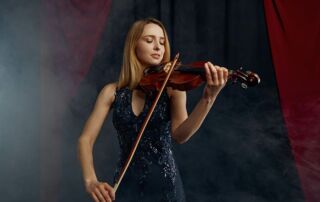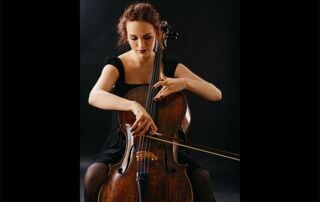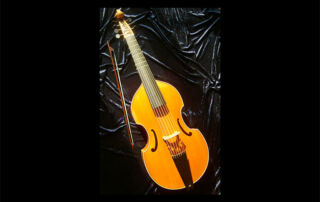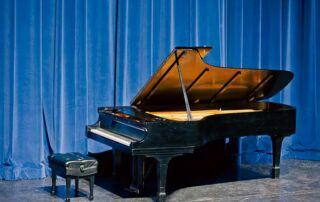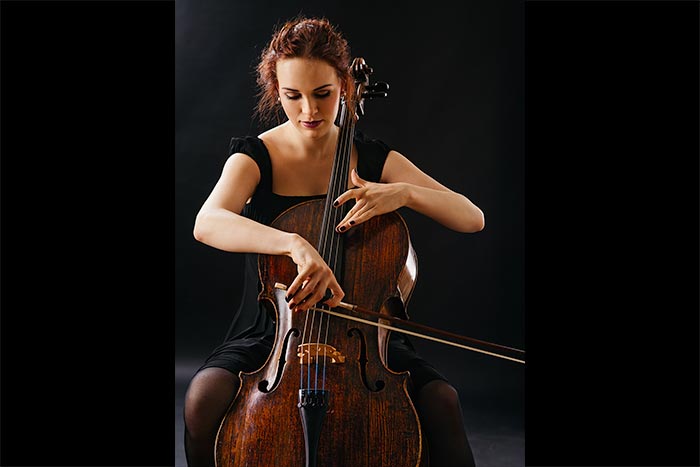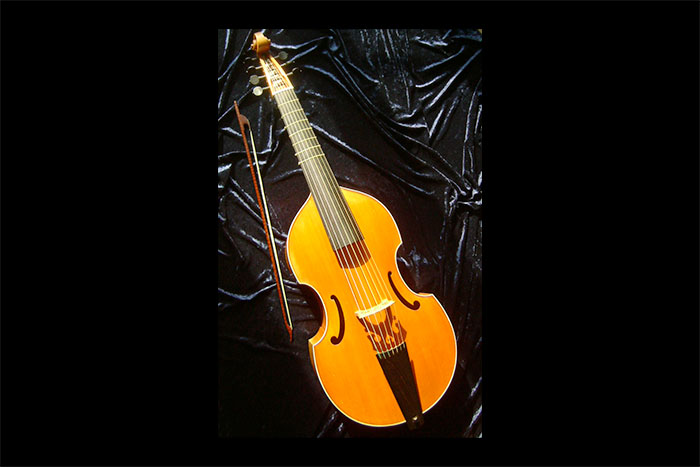This instrument holds a prominent place in Western classical music. It is considered one of the most popular instruments in the Western world!
The word 'violin' comes from the Italian 'violino,' a diminutive of 'viola' (viola).
The violin is a musical instrument from the family of bowed string instruments.
It is the smallest and has the highest pitch range among its family (including the viola, cello, and double bass) in classical music formations such as the string quartet or orchestra. It is also used in popular music, jazz, and contemporary music.
The anatomy of the violin
The violin consists of three parts: the head or scroll, the neck, and the resonating body. There are various sizes corresponding to that of the violinist.
From the smallest to the largest: Sixteenth, eighth, quarter, half, three-quarters, and full.
- The head of the violin, or scroll, is in the form of a spiral that winds around. Holes are drilled in it to accommodate the pegs, which allow for tightening or loosening the strings to tune the instrument.
- The neck, made of maple in contrast to the rest of the violin, is not varnished. Four strings tuned in fifths pass over it.
From high to low: E (or chanterelle), A, D, and G (the drone).
For a long time, the strings were made from sheep gut (small intestine). Only the G string was composed of gut wrapped in silver wire. Then, in the early 20th century, the E string was replaced with a steel string. The A and D strings were wrapped in aluminum.
The fingerboard, the black part placed on the neck, is made of very strong wood (ebony) to withstand the constant finger tapping of the musicians.
- The resonating chamber or the body of the violin is the largest part of the violin. It consists of a back (lower plate) and a soundboard (upper plate).
The two plates are joined by ribs on the sides. The soundboard is made of spruce, and the ribs are made of maple.
A wooden rod called the 'soul' connects the two plates and transmits the vibrations from the soundboard to the back plate. The sound is then projected outside of the instrument through the F-shaped sound holes (holes drilled on the soundboard).
There is also a bridge (made of maple) over which the strings pass, as well as a tailpiece that anchors them at one of their ends.
A brief history of the evolution of the violin
It is estimated that the violin was born in the 1520s around Milan, Italy. The first luthier to have crafted a violin is believed to be Giovan Giacomo Dalla Corna or Zanetto Montichiaro. The violin's organological characteristics were influenced by several instruments, including the rebec (derived from the Arabic rebab), the vielle, and the lira da braccio. One of the earliest clear descriptions of the instrument and its tuning in fifths can be found in 'Epitome of Music for Voices, Flutes of Germany, Nine-Hole Flutes, Viols, and Violins' by Philibert Jambe de Fer, published in 1556.
The violin quickly spread throughout Europe, serving both as a street instrument and as a cherished instrument of the nobility. Dance masters of the 16th and 17th centuries used a small violin, known as the 'kit' in English, 'violon pochette' in French, or 'taschengeiger' in German. They could conveniently store these violins in their large pockets and take them out whenever needed to accompany the dancers.
In France, at the beginning of the 17th century, the violin was considered 'good only for dancing.' France in the 17th century sought more intimate sounds rather than the spectacular effects of virtuosos, even though it had already begun its conquest of the musical world in Italy in the early 1600s. The violin family then experienced increasing success, eventually supplanting the viola da gamba. The violin became more prominent with the creation of the 'Twenty-Four Violins of the King' in 1626 and the influence of Jean-Baptiste Lully.
It was in Italy that the violin experienced its most rapid and spectacular growth. In the second half of the 17th century, the Bologna school produced great musicians like Francesco Geminiani and Arcangelo Corelli, and the forms of sonata and concerto grosso were born. In Cremona, Niccolò Amati, Andrea Guarneri, and Antonio Stradivarius contributed to the current form of the violin.
Later, during the 18th century, with Antonio Vivaldi, Giuseppe Tartini, and Pietro Locatelli, the technique and repertoire of the violin developed significantly. The most played and certainly the most well-known works of these composers hold an important place in the violin repertoire: Antonio Vivaldi's 'The Four Seasons' for violin and orchestra, or Giuseppe Tartini's 'Devil's Trill Sonata.'
The 18th century witnesses the emergence of a Germanic school of violin influenced by the Italians. Johann Sebastian Bach composed the famous Sonatas and Partitas for violin.
The publication of the "24 caprices for solo violin" op.1 as well as Niccolò Paganini's violin concertos marks a decisive advancement in the virtuoso possibilities of the instrument.
The 19th century in Germany is the era of the foundation of the great violin repertoire. German composers wrote four of the most famous concertos for the instrument.
In the 20th century, many composers attempted to write a concerto. It is also the time when the pitch of A, or "diapason," is standardised, as it had varied considerably over time.
The 1950s marked the resurgence of playing the baroque violin.
Here are some playing techniques used by the violinist:
- With the right hand without the bow: pizzicato, which involves plucking the strings.
- With the bow: tremolos, staccato, detached notes, legato, col legno, sul ponticello...
- With the left hand: vibrato, trills, left-hand pizzicato.
The most famous violinists include:
- Antonio Vivaldi
- Jean-Marie Leclair
- Yehudi Menhuin
- Nathan Milstein
- Ginette Neveu
- Hilary Hahn
- Anne-Sophie Mutter
As well as a list of the most famous concertos:
- Ludwig van Beethoven, Concerto in D Major, Op. 61
- Pyotr Ilyich Tchaikovsky, Violin Concerto in D Major
- Johannes Brahms, Concerto in D Major, Op. 77
- Felix Mendelssohn, Concerto No. 2 in E Minor, Op. 64
- Max Bruch, Concerto in G Minor, Op. 26
The most famous violins known for their magnificent sound are the "Stradivarius" and the "Amati." They are highly expensive and are often sold or lent to renowned violinists by patrons or foundations.
Have you always wanted to learn how to play the violin as an adult?
If you have always wanted to learn how to play the violin as an adult then you are in exactly the right place. At Institut de Musique de Paris we provide world-class violin lessons for adults of all ages and abilities. You do not need any prior experience and can start from scratch.
If you are not in Paris, you can also study with us from anywhere in the world. Visit our online violin lesson page here.
For our violin lessons in Paris, view our page for in-person violin lessons in Paris.







